|
ARBOR Technology SCP Cube
2-in-1 supercapacitor power and environmental monitoring solution offers compelling alternative to battery-based systems in terms of safety, maintenance, longevity
(by Conrad H. Blickenstorfer)
Share on:




What you see below is a UPS, an uninterruptible power supply. Those usually have batteries inside. Arbor Technology's SCP Cube doesn't. It uses supercapacitors instead. This article explains what supercapacitors are, how Arbor Technology is using them in their SCP Cube, and what the properties, applications and advantages of supercapacitor-based uninterruptible power supplies are.
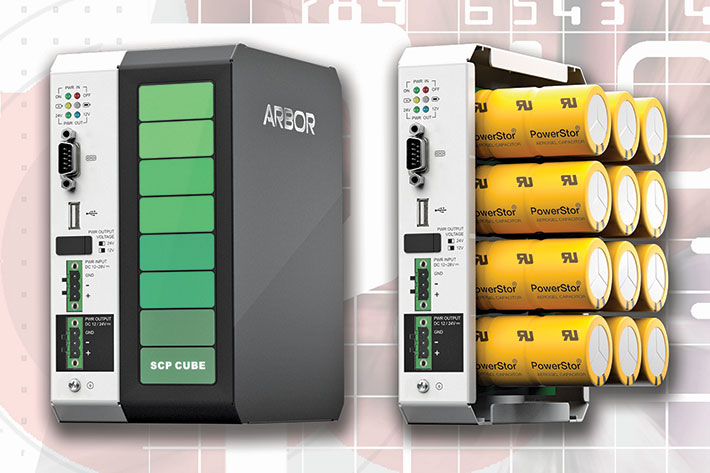
Safe, secure, uninterrupted power is crucial in today's world. That applies to homes, enterprise, commerce, industry and every other part and sector of modern life. While sometimes power "glitches" are nothing more than a nuisance that requires rebooting and resetting devices and appliances,  they are far more serious when they occur where productivity, safety and even lifes are at stake. they are far more serious when they occur where productivity, safety and even lifes are at stake.
Sudden power failures can destroy equipment, corrupt data, disrupt systems and much more. That's why there are backups. Uninterruptible power supplies guard against power glitches and short-term power loss by instantly switching to backup power. If the power comes back on, the backup power system simply switches back to grid power. If it doesn't, backup systems have enough capacity to allow for a graceful shutdown.
There are many different types of backup power supplies. Homes and workshops may have a simple gasoline or diesel engine-powered backup generator. Computers, however, require truly uninterrupted power and that means electronically controlled battery backups. Most UPS systems use internal batteries to provide short-term backup power.
Reliable power in today's industrial environments
Reliable power is particularly crucial in today's industrial environments. Highly automated sensor-driven and cloud-based Industry 4.0 installations, especially, rely on solid power. Power glitches and irregularities are not acceptable. Which makes safe, secure and autonomous uninterruptible power mandatory.
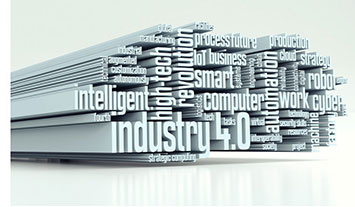 Power failures can lead to production downtime, data loss, hardware damage and worse. It must be avoided as much as possible. That's usually done with battery-powered backup systems. Those can maintain power through brief glitches, limited duration outages, or, at a minimum, provide enough backup power for standard shutdowns. Power failures can lead to production downtime, data loss, hardware damage and worse. It must be avoided as much as possible. That's usually done with battery-powered backup systems. Those can maintain power through brief glitches, limited duration outages, or, at a minimum, provide enough backup power for standard shutdowns.
Battery powered backups systems, however, have drawbacks. They are bulky and heavy. Batteries, based on chemical technology, degrade over time. They are sensitive to temperature variations. They need relatively frequent maintenance. They remain efficient only for a limited number of power cycles. And they require complex diagnostics systems.
Batteries have other drawbacks as well. Failing Lithium batteries can catch fire and do all sorts of damage (as we here at RuggedPCReview.com observed very recently when a handheld computer's battery overheated during charging, irreparably damaged the display, and swelled up to triple its size). In serious power glitch/loss cases, there may be downtime, asset loss, injury, environmental impact, and worse. This is where supercapacitor technology provides an increasingly interesting option.
Supercapacitors
A capacitors is essentially a different kind of battery. While conventional batteries store power via chemical processes, capacitors store energy as an electric field. Most capacitors are small and used in electronic circuits for a variety of purposes, such as filtering fluctuations or converting power. Supercapacitors have much larger capacity and can be used to store energy. That makes them suitable as battery alternatives.
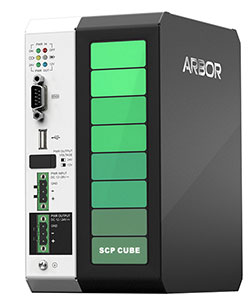 Arbor's SCP Cube is what the company calls the world's first 2-in-1 supercapacitor power and environmental monitoring solution. Arbor claims superior reliability, much reduced maintenance, simplicity and ease of use, inherent ruggedness, and also, compared to batteries, environmental friendliness. Arbor's SCP Cube is what the company calls the world's first 2-in-1 supercapacitor power and environmental monitoring solution. Arbor claims superior reliability, much reduced maintenance, simplicity and ease of use, inherent ruggedness, and also, compared to batteries, environmental friendliness.
Supercapacitor UPS solutions have a longer working life span than batteries, a wider operating temperature range, and much shorter recharge time than traditional battery UPS systems.
Further, unlike batteries that charge and discharge very slowly, capacitors both charge and discharge quickly. Unlike batteries, capacitors discharge completely, which can be a safety issue.
And unlike with batteries, with supercapacitors there is no danger of overcharging that can result in damage, fire or explosion. Finally, unlike batteries, capacitors barely degrade over time.
All of this makes Arbor's Supercapacitor UPS technology a very interesting proposition. However, supercapacitors are not meant to be a wholesale replacement for conventional batteries. Instead, supercap will likely emerge as an attractive complementary technology for a variety of power backup applications.
The table below shows a summary of the differences between supercapacitors and conventional Li-Ion batteries:
|
Comparison Supercapacitor vs Li-Ion Battery
|
|
Technology
|
Supercapacitor
|
Li-Ion Battery
|
|
Overload potential
|
No
|
Yes
|
|
Thermal runaway potential
|
No
|
Yes
|
|
Explosion risk
|
No
|
Yes
|
|
Full discharge possible
|
Yes
|
No
|
|
Charge temperature
|
-40 to 149F (-40 to 65C)
|
32 to 113F (0 to 45C)
|
|
Discharge temperature
|
-40 to 149F (-40 to 65C)
|
-4 to 140F (-20 to 60C)
|
|
Charge cycles
|
50,000 to 20 million
|
500 to 1,000
|
|
Charging
|
Very fast
|
Slow
|
|
Energy density (watt-hour/kg)
|
Low
|
High
|
|
Cost/watt-hour
|
High
|
Low
|
|
Power density(watts/kg)
|
High
|
Low
|
|
Energy supply
|
"quick and brief"
|
"slow and steady"
|
Design and construction of the ARBOR SCP Cube
The SCP Cube that Arbor came up with looks quite spectacular. It is a 6.3 x 4.1 x 7.4 inch box with chamfered corners. The housing is steel, the electronics part eggshell-white and the supercapacitor part black. A sequence of green bars graduating from dark to light presumably signifies the comparatively environmentally friendly — green — nature of the technology. A clear piece of acrylic dramatically displays the twelve big supercacitors.
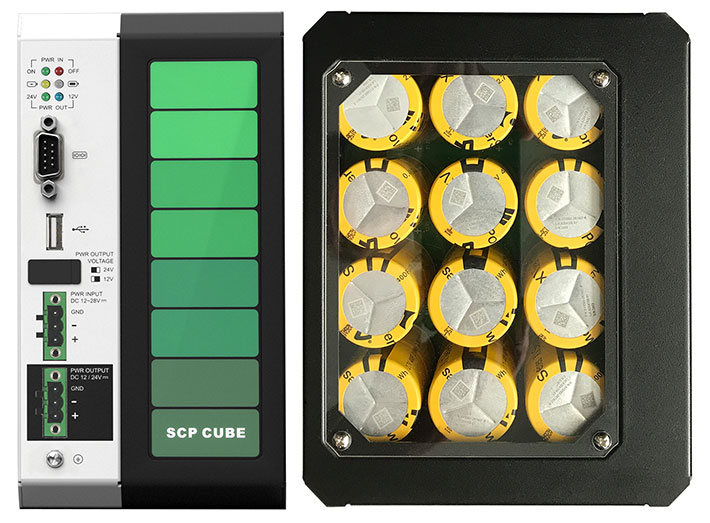
The SCP Cube weighs a not inconsiderable 4.75 pounds. A typical desktop multi-outlet lead-acid battery UPS system designed to provide backup power for a couple of minutes on full load and maybe 8-10 minutes on half load, such as the CyberPower 650VA 8-Outlet UPS, weighs about six pounds.
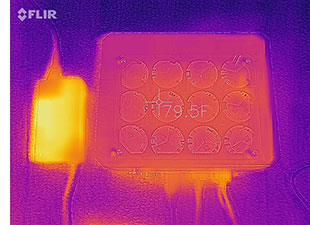 Since many Arbor SCP Cubes will likely be deployed in industrial settings, the all-steel housing is industrial-grade. The SCP Cube can handle a very wide -4 to 158F (-20 to 70C) operating temperatures range, is fairly immune to vibration, and the chassis is DIN-rail mountable just about anywhere. It also has a USB and an RS232 serial port (more on those later), and can accommodate 12 to 28 Volt power input. Since many Arbor SCP Cubes will likely be deployed in industrial settings, the all-steel housing is industrial-grade. The SCP Cube can handle a very wide -4 to 158F (-20 to 70C) operating temperatures range, is fairly immune to vibration, and the chassis is DIN-rail mountable just about anywhere. It also has a USB and an RS232 serial port (more on those later), and can accommodate 12 to 28 Volt power input.
The infrared picture to the right was taken with our FLIR One Pro heat imager camera (a marvelous little device that snaps on to an iPhone or Android smartphone). The bright yellow small box on the left is the actual power brick which, like all power supplies, gets hot during operation.
The larger device on the right is the SCP Cube itself. As you can see, the supercapacitors don't heat up at all. They're 79.5 degrees Fahrenheit (26.4 Celsius), not even was warm as the cables going in and out of the SCP Cube.
Below is a head-on look at the I/O panel of the Arbor SCP Cube and a list of the I/O present on the SCP Cube.

- Grounding screw
- Power input (3-pin terminal block)
- Power output (3-pin terminal block)
- Covered slide-switch 12V/24V
- 1 x Type-A USB connector (usually connects to protected host computer)
- 1 x DB9 RS232 COM port (this can be used to connect to edge sensors and peripherals)
- LED indicator/status lights
The SCP Cube LED power indicators
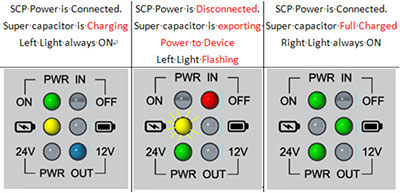 On the right is a depiction of the different states of the three pairs of indicator LEDs that provide information on the Arbor SCP Cube's connection and charging status. On the right is a depiction of the different states of the three pairs of indicator LEDs that provide information on the Arbor SCP Cube's connection and charging status.
The top pair shows the AC/DC power status (green = power, red = no power).
The middle pair shows the charging stats (yellow = SCP is charging, yellow flashing, SCP is being discharged, green = SCP is fully charged).
The bottom pair shows output voltage (blue = 12V, green = 24V).
Our test setup
Below you can see the test setup Arbor sent us. The SCP Cube SCP-43 on the left, acting as an uninterruptible power supply to an Arbor ASLAN W912C HMI panel to the right:
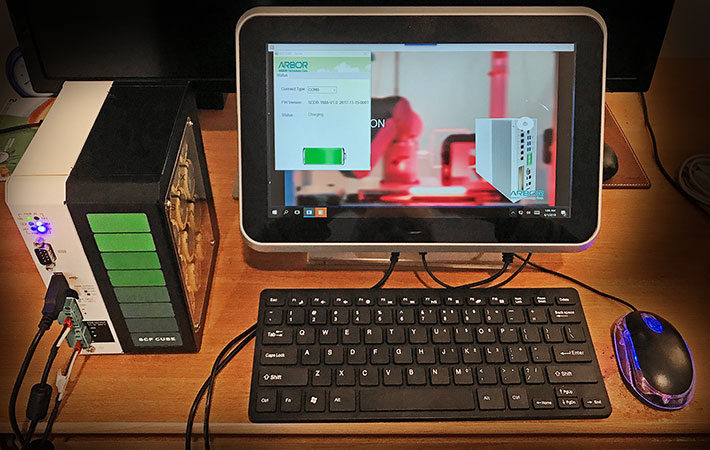
The SCP Cube demo utility
Our test system came with Arbor's SCP Cube demo utility. It provides settings for the SCP Cube which communicates with the computer via a male-to-male USB cable. The three screen captures below show,
- On the left, the home screen of the utility with the COM port selection, the software version, charging status, and a graphical representation of charge (which, oddly, uses a battery and not a capacitor);
- In the middle, the Settings screen that lets you select the target power state (see Intel System Power States), either S4 hibernation or S5 soft off (full shutdown and boot cycle when the power is back). Here you can also set the time between power failure and beginning of shut-down (30 to 240 seconds) or stay on until shortly before backup power is depleted and only then shut down.
- On the right you can see the countdown upon power failure. In this instance, the utility was set to 240 seconds.
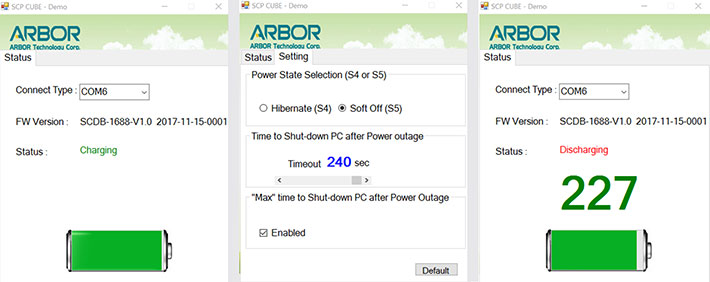
All that said, what sort of real world backup time can one expect from a supercapacitor UPS, and how can a system be sized for a specific application>?
Capacitor capacity and run time calculations
Let's look at some capacitor basics. As stated above, a capacitor is an electronic component that can store an electric charge much like a battery can. The difference is that a conventional battery uses a chemical process to slowly and continuously generate its own charge until the battery is either depleted or, if it's a rechargeable, recharged. A capacitor, on the other hand, is charged and then discharged. It does not have electrolyte which chemically generates electricity that goes from the positive to the negative terminal.
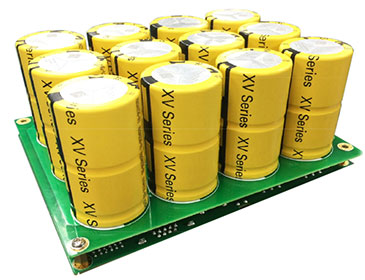 A capacitor's storage potential is measured in farads. A 1-farad capacitor can store 1 coulomb (a measure of the number of electrons) at 1 volt, which corresponds to 1 amp-second. A capacitor's storage potential is measured in farads. A 1-farad capacitor can store 1 coulomb (a measure of the number of electrons) at 1 volt, which corresponds to 1 amp-second.
To get an idea of what 1 amp-second represents, consider that a good AA battery may be able to generate 4.2 watt-hours (1.5 volts x 2,800 mAH). So what kind of capacitor would be needed to store the same amount of energy as a AA battery? That would be 3,600 amp-seconds x 2.8 amps x 1.5 volts = 15,120 farads.
How does that relate to the storage capacity inside the Arbor SCP Cube? The SCP-43 model has twelve 400 farad supercapacitors, for a total of 4,800 farads. Nominally that's no more than roughly a third of a AA battery.
How does that match up with the power draw of a computer? We generally do battery drawdown testing as part of our detailed mobile computing product reviews. The ASLAM W912C industrial panel PC Arbor sent us for reviewing the SCP Cube doesn't have an internal battery, but its tech specs are similar to some battery-powered products whose battery drawdown results we have on file.
|
Arbor SCP Cube backup time (minutes)
|
|
Load
|
SCP Cube-43
|
SCP Cube-41
|
|
60 watt draw
|
02:28
|
00:49
|
|
50 watt draw
|
03:07
|
00:59
|
|
40 watt draw
|
03:59
|
01:17
|
|
30 watt draw
|
05:48
|
01:53
|
|
20 watt draw
|
09:35
|
03:08
|
|
Arbor ELIT-1850
|
09:16
|
03:02
|
|
Arbor FPC-7900
|
04:11
|
NA
|
The table to the right shows the results of Arbor's own backup time testing. It indicates the time the SCP Cube-43 (12 supercapacitors) and the SCP Cube-41 (4 supercapacitors) lasted upon loss of power. Testing was done with steady power draws from 20 to 60 watts, as well as using two of Arbor's industrial PCs running a standard software app.
In our own battery drawdown testing of laptop and tablet computers here at RuggedPCReview, we see idle draws of between 3 and 12 watts. So a AA battery with 4.2 watt-hours could drive these systems between 0.35 and 1.4 hours. That's with the 15,120 farads in that battery. The 12 superconductors hold 4,800 farads or 1.333 watt-hours, so our typical test systems would draw that down within 0.111 to 0.444 hours, or 6.77 to 26.7 minutes.
The Arbor ASLAN W912C has an Intel Core i5-6300U processor and an 11.6-inch screen. That's similar enough to a Core i7-6500U test tablet with an 11.6-inch screen that drew about 7 watts idling along in the RuggedPCReview.com battery drawdown test. So let's assume that the ASLAN W912C draws the same 7 watts. How long should it last on 4,800 farads?
That'd be 1.333 watt-hours divided by 7 watts = 0.19 hours or about 11.4 minutes.
And how long did the ASLAN W912C last when we manually disconnected the power from the SCP Cube? 10.5 minutes. Which is very close to what we expected. It is also more than enough time for a graceful shutdown. A second test, with the ASLAN W912C continuously running video, yielded 8:30 minutes running on the supercap backup, also as expected.
LoRa integration
In our discussions with ARBOR, company representatives mentioned that upcoming their SCP Cube supercapacitor-based ower backup systems may also be equipped with LoRa technology. 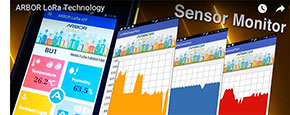
LoRa is a wireless data communication specification for use in LPWAN (Low Power Wide-Area Network) applications. LPWAN is inexpensive, uses very little power, has good range, and is fast enough for communication with IoT sensors. It's therefore perfect for private wireless sensor networks that don't even need the internet.
Arbor has been developing a number of LoRa products (gateways, edge sensors, actuators, devices — see here) and suggests that these can be combined with SCP Cubes to keep track of sensor data as well as power and systems temperature points, and wirelessly provide real-time data via HMI or even mobile apps.
Summary: ARBOR SCP Cube supercapacitor-based UPS
With the supercapacitor-based SCP Cube series, ARBOR Technology offers a very interesting alternative to conventional battery-based uninterruptible power systems. While the SCP Cube is not intended as a UNIVERSAL replacement of battery backups, supercapacitor technology offers a number of distinct advantages over chemical batteries that make it a compelling proposition in numerous industrial and HMI deployments.
Eliminating many potential risk factors of conventional battery technology and offering much faster charging, far more charge cycles, lower maintenance requirements and longer lifecycles, supercapacitors point the way to greener backup solutions and lower total costs of ownership.
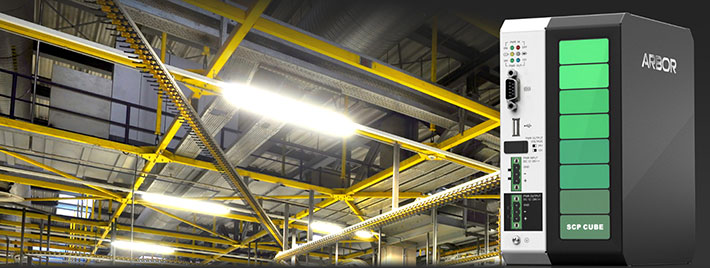
Arbor's SCP Cube currently (June 2018) comes in two varieties, with either four or twelve supercapacitors. The higher capacity SCP-43 model we tested weighed about five pounds, and reliably provided about ten minutes of backup power to a typical industrial PC HMI system.
Very fast recharge, the availability of configuration utilities, onboard connectivity to external sensors and instruments, and the emergence of Low-Power Wide Area Network LoRa connectivity opens new horizons in intelligent IIoT solutions. - Conrad H. Blickenstorfer, June 2018
| Status |
Added 05/2018
|
| Type |
Supercapacitor UPS
|
| Chip |
High current supercap backup controller
|
| Supercapacitor |
400 Farads / each
|
| Power Requirement |
Input: DC 12~28V input support
Output: DC 12V / 24V output with switch support
|
| I/O |
1 x 3-pin terminal block power in, 1 x 3-pin terminal block power out, power control switch, 1 x USB-A, 1 x DB9 RS2323 serial
|
| Housing |
DIN rail-mounting chassis, and SECC steel chassis
|
| Vibration |
0.5 Grms/5~500Hz/random operation
|
| Shock |
Operating 10G (11ms), non-operating 30G
|
| Humidity |
10 ~ 95% RH @ 60°C (non-condensing)
|
| Size |
3.94 x 5.91 x 7.4 inches (100 x 150 x 187mm)
|
| Weight |
5.0 lb (2.25kg)
|
| Price |
Inquire |
| Datasheet |
ARBOR SCP Cube
|
| Contact |
ARBOR Technology Headquarters
10F., No.700, Zhongzheng Rd.,
Zhonghe Dist., New Taipei City 235, Taiwan
Tel: 886 2 8226 9396
Fax: 886 2 8226 9398
Email: sales@arbor.com.tw
Web: www.arbor-technology.com
|
|




